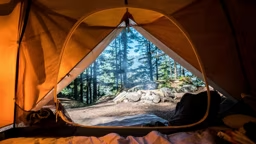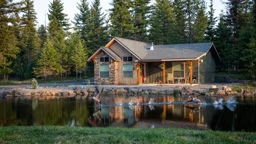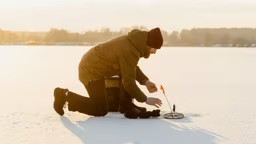
Photo Credit: Rob Bick
And then you feel it. A bit of a fishtail, a loss of speed like skiing across a patch of dirt. You dare yourself to look back, knowing full well the “abominable snowman” of riding conditions is taking hungry swipes at your snow-flap.
You have just mined slush.
Dealing with slush is an important skill for any snowmobiler. Of course, the best defense against slush is to avoid riding on frozen lakes and rivers altogether since ice conditions are never guaranteed. Ice conditions can change in a period of several hours. Nonetheless, asking a snowmobiler to avoid crossing lakes is akin to asking a football player to avoid playing in mud.
Sometimes crossing a lake is unavoidable; occasionally it’s irresistible.
If you must cross ice, try to stay on a packed or marked trail. Don’t stop until you reach shore. When traveling over lakes and rivers consider using a buoyant snowmobile suit that – if you break through the ice entirely – will assist you to reach the closest ice surface. Also, carry a set of ice picks. These will help you grip the edge of the ice more easily if you break through.
Slush initiation
My first experience with slush occurred at the age of 11 on Big Moose Lake near Old Forge, N.Y. My uncle, my cousin, my brother and I went for a “morning after the thaw” ride. We dutifully followed Uncle Bill out onto the lake and one by one, we all broke through the recently formed crust into the slush below. Being new to snowmobiling over lakes and not knowing anything about ice formation, we all panicked, thinking that we were moments away from being helmet-clad bobbers.All four of us piled on the ’72 Nordic wide-track and made a break for the shoreline, leaving our slush-encased sleds behind.
We had no idea that the locals at the Big Moose Inn were watching us “flatlanders” from Syracuse with binoculars. They informed us, after a rousing dose of applause, that there was actually ice under the watery slush – we better return to the lake and remove our sleds before they were frozen in place.
And so it was that I received my first lesson in understanding the trials and tribulations of riding ice. But my schooling had just begun.
Where does slush come from anyway? A common explanation is that water is forced up through pressure cracks in the ice and mixes with snow at the surface. Another explanation: A thaw/freeze cycle turns the snow pack on top of the ice into a slush sandwich with an icy crust on top and lake ice underneath.
Soon after the Big Moose Lake incident my family built a cottage in the northern Adirondacks – the perfect classroom for a student of remote snowmobiling. Our cottage lies an hour northwest of Lake Placid on Lake Ozonia. This was virgin territory. No tourists, no groomed trail, no signs, no services. With a compass, a backpack, an old Alouette Eliminator 295, and a desire to explore the great beyond, I was off. Off meant “off the trail” – and “off my rocker” for going some of the places I went alone.
See also 10 Keys to Family Fun
What you must know
Slush can surprise you; it is sometimes hidden beneath a layer of fresh powder snow. If you find yourself in slush, don’t panic, but take it seriously because slush may indicate weak or deteriorated ice.There are a number of things you can do to get yourself and your sled through safely:
- Don’t follow someone’s fresh slush prints. If you are following someone who hits slush, veer off to make your own path – preferably on more solid ice.
- Speed is an asset. If you hit slush, don’t let off the throttle. Chances are, by keeping up your speed you can drive right out of the soup.
- If you get into it, don’t stop. As they say in physics, an object at rest tends to stay at rest, while an object in motion tends to stay in motion. In this case, motion is obviously better.
Despite my best efforts, I still get stopped by slush on occasion. The most effective way I have found to get the sled moving again is to lift the sled out of the slush hole onto fresh snow if possible, initiate momentum by gently giving it gas, walk alongside the sled as it begins to move (run alongside if necessary), then hop on, squeeze that love handle and hang on.
If your boots get sucked off in the process, make a judgment call. How far away are you from camp, how cold are your feet and do you want to go through this ordeal again without your boots on?
Exploration requires preparation
Snowmobiling to me is motorized cross-country skiing. My love of remote snowmobiling means an occasional encounter with slush.
Thus, my advice to those who venture into the backwoods: buy the right equipment; carry the appropriate tools for backcountry snowmobiling; don’t follow immediately behind another sled; and always carry a spare pair of boots, because you never know when old man winter will unceremoniously borrow yours.
If the Ice Gives Way Entirely
If you do break all the way through the ice, don’t panic. Follow these self-rescue tips:
Rob Bick, an avid skier, snowmobiler, climber and photographer, would rather spend a cold snowy day in the mountains than a warm, sunny day by the pool.
- Kick vigorously into a horizontal position and swim to the nearest ice edge. Place hands/arms on unbroken ice – using ice picks or anything sharp to dig in – while kicking hard to propel your body onto the ice, like a seal.
- Once clear, stay flat and roll away to stronger ice.
- Stand, keep moving and find shelter fast.
Rob Bick, an avid skier, snowmobiler, climber and photographer, would rather spend a cold snowy day in the mountains than a warm, sunny day by the pool.










